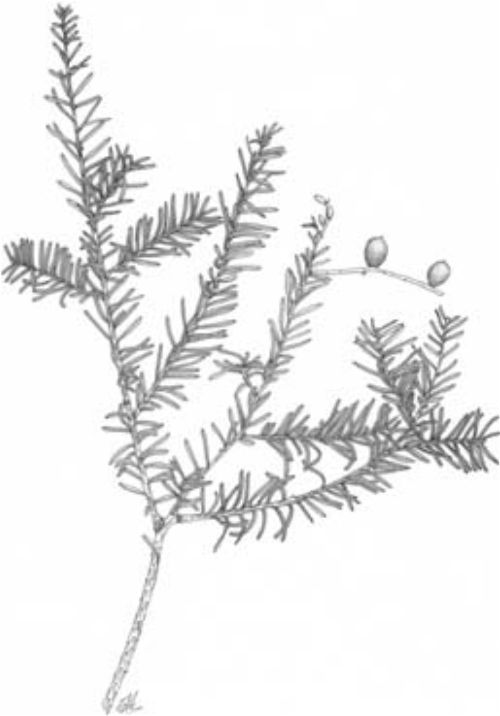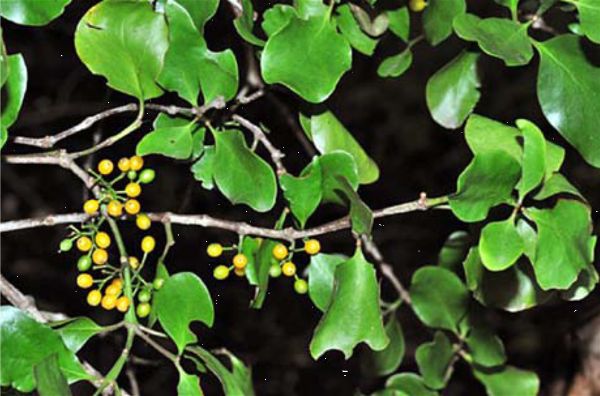Trip Report – 15 May 2010: Te Marua Bush Workbee
 |
| Matai. Illustration: Eleanor Burton. |
We began by planting in gaps in the plantings in the southern section of the site, weeding as we went, then weeded around the plantings in the planted strip alongside Te Marua Lakes Road, north of the bush. The unusual aspect of the day was demolishing an illegal campsite in the bush, and removing a sofa, chairs, a coffee table, timber and bottles, to the road, for loading onto the ranger’s ute.
Participants : Steve Edwards (GWRC ranger), Chris Horne (scribe), Sue Millar (co-leader), Barbara Mitcalfe, Chris Moore, Richard Northmore, Jeremy Rolfe, Alan Sheppard, Glennis Sheppard (co-leader).
Vandalism in Te Marua Bush
About fifteen years ago we found a tree house had been built in the Bush, using four, live, standing matai as supports. Within two or three years all four had died. On 15 May last, on arriving at the Bush for our weeding workbee, we were disconcerted to find a camp had been set up among a group of six matai. We removed all traces of it, including a tarpaulin which had been attached to the live, standing, tree trunks by nine, 75 mm galvanised nails, driven in deeply – since removed*. These had caused wounds that were weeping, and we have yet to find out whether the trees have been permanently damaged or even killed. These stately, columnar trees c. 15m high, and with c. 30 cm d.b.h., are one of the features of this highly significant, secondary, closed-canopy matai-totara / black maire forest remnant, a rare type of forest on a national scale and not known elsewhere in the Hutt catchment. Greater Wellington Regional Council have been advised of the vandalism.
*The holes left by the nails have been covered with vaseline, to prevent the ingress of moisture or disease.
Barbara Mitcalfe.
Trip Report – 2 October 2010: Te Marua Bush Workbee
General
As before, our workbee was ably supported by our joint Wellington BotSoc-Upper Hutt Branch, Forest and Bird Society members who collect and propagate eco-sourced seed for our workbees there.
Natives
 |
| Ileostylus micranthus at Te Marua Bush. Photo: Chris Moore. |
All in all, the Bush itself and the two extension areas are in good order, and our latest plantings are thriving. Since this workbee was planned for filling gaps in the plantings, rather than for weeding, we were lucky that the weather had been wet enough for long enough, to make planting still practicable. In the new northern extension, rank grass has been deliberately left around the plants to deter rabbits and hares. Checking the canopy with binoculars showed that the previously-thinly-foliaged black maires appear not to have declined further. In the northwest corner, the Ileostylus micranthus mistletoe was in flower.
Weeds
Most of the weeds in the Bush itself are concentrated on the northeast edge, resulting from the realignment of SH2 a few years ago. In the Bush itself, wisps of tradescantia appear from time to time, and montbretia is becoming a problem again near the west side, near the south end, a few metres inside the fence. On the western margin, spraying by the ranger has killed most of the dense weed infestations near the fence.
In the northern extension, there are still a few common broom plants that need removing, but we did not have time on this occasion. Broom also appears in the narrow access strip beside the fences separating the Bush from the pony paddock. It would be good if it could be sprayed wherever it appears and before it flowers.
Fence
Near the northwest corner of the Bush, the pony paddock fence needs repairing.
Eleven participants spent about four hours on site in perfect weather.
Barbara Mitcalfe